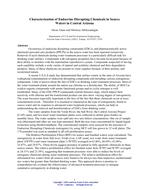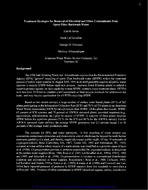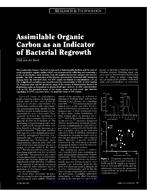A recent U.S. Geological Survey study has demonstrated that surface waters in the state of Arizona havewidespread contamination of endocrine disrupting compounds (EDCs) and including various estrogenouscompounds. Little is known about the fate of EDCs in drinking water treatment processes. Most ofthe water treatment plants around the nation use chlorine as a disinfectant. The ability of HOCl tooxidize organic compounds with amine functional groups and/or cyclic nitrogen is wellestablished. Many of the EDC/PPCP compounds contain benzene rings, which impact theirreactivity with chlorine and the transformed product can also show varying degree of estrogenicity.The issue becomes especially important in light of the fact that these chemicals occur at traceconcentration levels. The objective of this study was to characterize the type of estrogenicity found insource water and its response to advanced water treatment processes, which can help inunderstanding the removal and transformation of EDCs from drinking water.The water samples from the Verde River, the Salt River, the Central Arizona Project(CAP) canal, and two local water treatment plants were collected in amber glass bottles on amonthly basis. The water samples were split into two sets before concentration. One set of sampleswas chlorinated and the other set was kept untreated. Both the sets were concentrated by liquid-liquidextraction using Dichloromethane. The concentrated samples were assayed for the presence ofEndocrine Disrupting Chemicals (estrogenic) by using MCF cell line grown in 12 well plates. The17b-estradiol was used as standard in all cell proliferation assays.The Relative Proliferation Effect (RPE) for source and finished waters were calculated. Theestrogenicity in water from the Salt River, the Verde River, CAP canal, raw water from water treatmentplant 1 (WTP1) and water treatment plant 2 (WTP2) averaged at 62.46%, 66.69%, 63.06%,35.87%, and 29.87%. These levels suggest the presence of partial to fully agonistic chemicals in thesesource waters. The relative proliferation effect for finished water from WTP2 and WTP1 averagedat 24.31% and 23.58%, suggesting that treatment processes were able to reduce the levels ofestrogenic chemicals during water treatment processes. The relative proliferation effect forchlorinated raw waters from all sources were found to be always less than respective unchlorinatedraw waters but greater than finished drinking water. This approach shows a promise tocomprehensively evaluate the effectiveness of advanced treatment processes to mitigatecumulative estrogenicity in drinking water. Includes figures.





